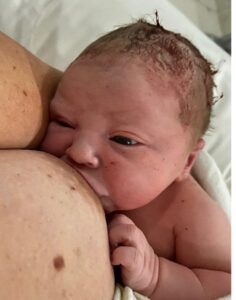The first moments after birth are a crucial time for establishing a strong bond between a mother and her newborn baby. Among the various practices that promote this connection, the baby’s breast crawl stands out as an extraordinary and instinctual behaviour. Also known as “breastfeeding initiation,” this phenomenon involves a newborn’s innate ability to navigate their way to their mother’s breast, guided by their senses and natural instincts.
The breast crawl is a remarkable journey undertaken by newborns, signalling their readiness to receive nourishment from their mother’s breast. Within moments of birth, when placed skin-to-skin on their mother’s abdomen, babies instinctively begin to move towards the breast. This innate behaviour is guided by a combination of factors, including the sense of smell, touch, taste, and innate reflexes.
The sense of smell plays a significant role in the breast crawl. Newborns possess a heightened sense of smell, which enables them to detect the scent of amniotic fluid and the familiar aroma of their mother’s breasts. By following this scent, babies can locate their mother’s nipple accurately, even without visual guidance.
The sense of touch also plays a vital role in the breast crawl. The newborn’s skin-to-skin contact with their mother’s abdomen provides them with a tactile map, allowing them to explore and find their way to the breast. The skin-to-skin contact also helps regulate the baby’s body temperature, heart rate, and breathing, creating a nurturing and comforting environment for the infant.
Additionally, the taste of the mother’s skin contributes to the initiation of breastfeeding. The taste of the mother’s sweat contains chemical signals that guide the baby’s instinctual response, leading them towards the breast. This taste preference helps the newborn distinguish their mother’s breast from other objects and reinforces the bond between mother and child.

The breast crawl holds numerous benefits for both mother and baby, fostering a positive breastfeeding experience and supporting the overall well-being of the newborn. First and foremost, the breast crawl facilitates early breastfeeding initiation, ensuring that the newborn receives colostrum, the nutrient-rich first milk produced by the mother. Colostrum is a concentrated source of vital antibodies, proteins, and immune factors that help protect the baby against infections and boost their immune system.
The breast crawl enhances the establishment of a successful breastfeeding relationship. By allowing the newborn to self-attach to the breast, the baby is more likely to latch effectively and stimulate milk production. This process aids in preventing nipple confusion and reducing the risk of breastfeeding difficulties such as sore nipples or low milk supply.
The breast crawl also promotes emotional bonding between mother and baby. As the baby navigates their way to the breast, both mother and child experience a surge of oxytocin, often referred to as the “love hormone.” Oxytocin release not only facilitates milk letdown but also fosters feelings of warmth, affection, and attachment between mother and baby. This emotional connection established during the breast crawl lays the foundation for a strong and nurturing relationship that extends beyond breastfeeding.

Furthermore, the breast crawl contributes to the overall well-being of the newborn. The skin-to-skin contact during the breast crawl regulates the baby’s body temperature, minimizing the risk of hypothermia. It also promotes stable heart rate, respiratory function, and blood sugar regulation.
I have attached a video of my second born daughter doing the breast crawl. This was unplanned so we only got the end part on camera as we noticed she had made her way down to my nipple from up under my chin while we were chatting and debriefing. I am so grateful I got to experience this incredible moment. Babies are amazing!
My name is Jade Ball and I am a Doula who has completed training at the Doula Training Academy with Vicki Hobbs. If you would like to talk to me more about your birthing options, please contact me:
Business Name:
Jade Ball Doula
Business Email:
[email protected]
Phone:
0421 472 344
Facebook Link:
Jade Ball Doula | Facebook
Instagram Link:
https://instagram.com/jadeballdoula/
Resources
- Breast Crawl: Your First Breastfeed After Birth (healthline.com)
- Midwifery Today The First Hour Following Birth: Don’t Wake the Mother! The heart and science of birth
- Chemical communication and mother-infant recognition – PMC (nih.gov)
- The effect of mother and newborn early skin-to-skin contact on initiation of breastfeeding, newborn temperature and duration of third stage of labor – PMC (nih.gov)
- Skin‐to‐skin contact the first hour after birth, underlying implications and clinical practice – Widström – 2019 – Acta Paediatrica – Wiley Online Library
- Impact and feasibility of breast crawl in a tertiary care hospital | Journal of Perinatology (nature.com)
- Efficacy of the Standard Breast Crawl Technique on Maternal and Newborn Outcomes After Term Vaginal Birth: A Randomized Controlled Trial – PubMed (nih.gov)

